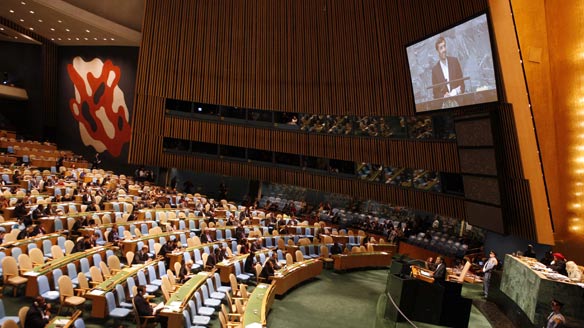There is one question I want to ask you, Mr Ahmadinejad, before you address the UN: how long does it take to make an Iranian documentary filmmaker?
 Maziar Bahari, the Newsweek reporter who was arrested on 21 June and is still held in solitary confinement in Tehran’s notorious Evin prison, decided to become a filmmaker when he was 10 years old. From the age of 12, he began meeting his heroes — photojournalists, filmmakers and reporters who covered the 1979 Islamic revolution and the 1980-88 Iran Iraq war. These were men who defended Iran when western governments armed Saddam Hussein. Some of them have since died in the field, doing their job. Maziar Bahari comes from such sturdy stock.
Maziar Bahari, the Newsweek reporter who was arrested on 21 June and is still held in solitary confinement in Tehran’s notorious Evin prison, decided to become a filmmaker when he was 10 years old. From the age of 12, he began meeting his heroes — photojournalists, filmmakers and reporters who covered the 1979 Islamic revolution and the 1980-88 Iran Iraq war. These were men who defended Iran when western governments armed Saddam Hussein. Some of them have since died in the field, doing their job. Maziar Bahari comes from such sturdy stock.
His early films, once he returned to Tehran after studying film in Canada, explored the city’s nascent art scene. Art of Demolition (1998), about a samizdat art gallery in a derelict house, featured artists who have since become internationally prominent in the lucrative new wave of contemporary Iranian art. Paint! No Matter What (1999) told the story of the artist Khrosrow Hassanzadeh,, a former Basij (revolutionary militiaman) who sold vegetables. The film showed that the Islamic Revolution shattered old institutions in a country where art under the Shah was an elitist pursuit.
Maziar began reporting in Iraq as a freelance news journalist for ITN and BBC about five years ago. He admitted that the doors normally closed to Western reporters in southern Shia-controlled Iraq opened for him. His short news film on the call centre of Ayatollah Sistani challenges stereotypes that Shi’ism is a religion mired in the past.
Afterwards there was an easy camaraderie between Maziar and the Ayatollah’s men. Whenever he was editing a film in London and they were passing through town, everyone met for dinner. Afterwards Maziar told me about the stories and laughter that lit up the table. Sistani’s people knew Iranian filmmakers don’t grow on trees.
But news freelancing showed Maziar the inadequacies of war reporting for some of the stories he felt had to be told. His plays A Fairly Justified Revenge and Romance in Abu Ghraib, included in 1001 Nights Now, directed in the UK by Alan Lyddiard, were from his reporter’s notes and interview transcripts. They were rare examples of the crossover between Middle East reportage and theatre.
I remember we discussed documentary as the most modern form of storytelling during the Iran/Iraq Masterclass he gave at the Institute of Contemporary Art in London in 2006. He said what was important to him in his work was to document the social transformation of his country. This is the underlying motivation of many of the photojournalists we included in the anthology we edited together, Transit Tehran: Young Iran and Its Inspirations, published earlier this year by Garnet Publishing and the Prince Claus Fund Library.
For Maziar and these photographers, showing was more than enough. It countered both the official state-sanctioned version of life in the Islamic Republic, and western misconceptions of what goes on there. The exhibition, Transit Tehran: Art and Documentary from Iran, opening in London at LSE’s Atrium Gallery on 28 September, is dedicated to Maziar and this view.
In Transit Tehran, he acknowledges the men who inspired him. One was photographer and cameraman Kaveh Golestan, who was killed by a landmine while on assignment for the BBC in northern Iraq in 2003. Another is Rastani, the Iranian Richard Avedon who photographs the inhabitants of the Iranian street in front of an iconic white backdrop. And another was the cartoonist and political satirist Ardeshir Mohasses, who died last year. When he met Maziar in 2007, Mohasses he was suffering from Parkinson’s disease. Although his death was drawing near, the older artist drew pictures for a younger one in the full flood of life.
Maziar has always been a conduit for Iranian arts and culture. Last year he produced nine short documentary films with young Iranian filmmakers in an intensive workshop programme, held in different cities over several months and supported by BBC World Service Trust.
Through films, plays, magazines, newspapers and books, Maziar has shown himself to be Iran’s renaissance man, a person completely formed of and by his times, producing work that illuminates and shocks. Even in solitary confinement he is astute enough to know that gatekeepers and mediators are obsolete. Since the disputed elections in June, a new face has emerged from Iran, one less concerned with nuclear enrichment than with the aspirations of ordinary men and women.
Mr Ahmadinejad, free Maziar Bahari. You can cut down a thousand forests and wait for them to grow back again, but you won’t find another like him.





